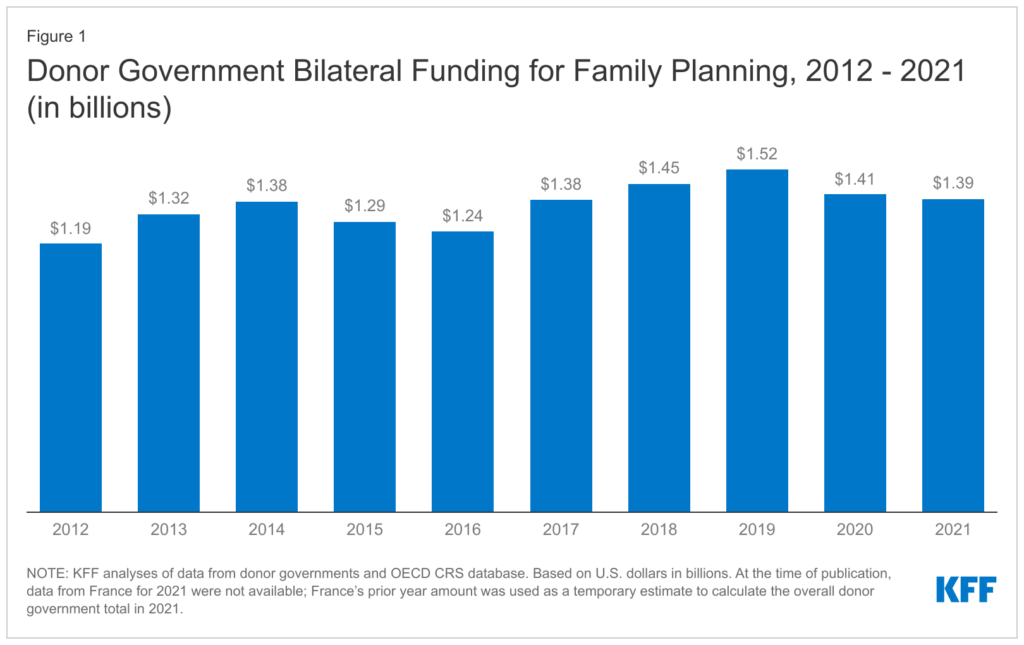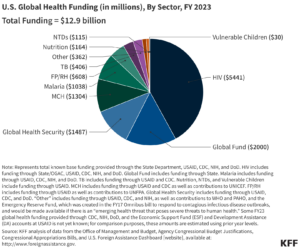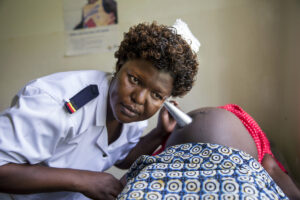What has happened to funding for international family planning?
Written by Olivia Nater | Published: March 22, 2024
Funding for international family planning programs has stalled, while the number of women in need of contraception keeps growing. Empowering women to choose whether and when to get pregnant is key to fulfilling basic human rights and generates unmatched benefits across all areas of development. So why aren’t governments prioritizing it?
A worthwhile investment
Family planning is one of the most cost-effective development interventions. Modern contraception allows people to prevent unintended pregnancies, and reduces unsafe abortions and maternal and infant deaths. When women have control over their fertility, they generally choose smaller families, making it easier for them to participate in the labor market, and enabling higher resource allocation per child. Preventing teen pregnancies allows girls to stay in school, giving them a better chance of fulfilling their dreams. As a result, families and entire societies are more likely to thrive.
Slowing population growth in developing countries also enables them to reap the demographic dividend, whereby the proportion of young dependents shrinks while the number of working age people grows, facilitating accelerated economic development and freeing up resources for other areas, including critical public services and infrastructure.
It’s been calculated that every $1 invested in addressing the unmet need for contraceptives generates on average $120 in annual benefits, including $30-$50 from reduced infant and maternal mortality, and $60-$100 in long-term benefits from economic growth.
Falling short
Despite these unmatched benefits, funding for family planning falls far short of what is needed. At the London Family Planning Summit in 2012, nations pledged to ensure that an additional 120 million women and girls would have access to modern family planning by 2020. The resulting FP2020 partnership achieved only half this goal, however, reporting in 2020 that contraceptive users increased by just 60 million.
Today, an estimated 257 million women have an unmet need for modern contraception, meaning they want to avoid pregnancy but are not using a reliable, effective form of birth control. Despite rapid growth in the number of contraceptive users since 1990, the total number of women with an unmet need has also increased because family planning programs are not keeping pace with population growth.
The UN estimates that the cost of ending the unmet need for family planning in 120 priority countries from 2020 to 2030 is $68.5 billion, but the amount of development assistance pledged for this decade in those countries is only $8.6 billion, leaving a $59.9 billion funding gap.
Funding for international family planning has unfortunately largely stagnated for over a decade. According to finance data collated by KFF, total bilateral aid for family planning disbursed by OECD governments has hovered between $1.2 and $1.5 billion since 2012.

Spotlight on U.S. funding
The United States is the biggest funder of international family planning, accounting for around 42 percent of total bilateral disbursements in 2021. The $605.7 million the U.S. spent on international family planning in 2023 is 45 percent less than the 1995 funding level when accounting for inflation. In addition, because the number of women of reproductive age in the developing world has grown by over 540 million since 1995, available funding per woman has dropped by 63 percent, from just under a dollar to only 36 cents.
While the U.S. contributes the highest total amount of family planning assistance of all countries, its contribution relative to the size of the U.S. economy is relatively low. Overall, the U.S. spends just 0.23 percent of its Gross National Income (GNI) on development aid — far below what the majority of other OECD countries spend (and far below the 0.7 percent UN target). PAI, using data from the Guttmacher Institute, has calculated that based on the size of the U.S. economy, the appropriate U.S. share of the total annual funding required to end the unmet need for family planning in developing countries is $1.74 billion — almost three times higher than the current U.S. contribution. According to Guttmacher, increasing U.S. assistance to this “fair share” amount would prevent 20.3 million more unintended pregnancies and 35,000 more maternal deaths every year.
Why is family planning being neglected?
1) Deprioritization of population stabilization
Concern over the negative impacts of rapid population growth and the challenge it presents to poverty alleviation efforts were widespread during the 60s and early 70s, aided by popular publications including Paul Ehrlich’s The Population Bomb (1968), and the Club of Rome’s The Limits to Growth (1972). For a while, this concern helped channel much-needed funding to family planning programs around the world. However, coercive population control policies, most notably in India and China in the 70s and 80s, led to sensitivities around discussing ‘population’ at government and international levels.
In 1994, the landmark International Conference on Population and Development (ICPD) in Cairo sought to reframe the population discussion around individual sexual and reproductive health and rights (SRHR). While the conference’s Programme of Action remained honest about the challenges posed by rapid population growth and the benefits of lower fertility, it was interpreted in many circles as a call to disconnect SRHR from demographic trends, and to end all pursuit of population stabilization.
Some experts argue that this “toxification” of the population discourse unintentionally led to deprioritization of international family planning, with donors moving away from funding programs due to fear of stoking controversy.
In a 2008 speech, Steven Sinding, a Senior Fellow at the Guttmacher Institute, argued,
“I believe that without intending to do so, the architects of the Cairo consensus, as it is often called, transformed family planning from what had been seen as a global imperative to one among many desirable but non-essential public services. The crisis mentality that had sustained such high levels of support and so high a priority for family planning in the years before Cairo was no longer present at Cairo and it has almost entirely disappeared in the years since Cairo.”
Unfortunately, this population “toxification” seems to have increased in recent years, with some SRHR groups and organizations, including ones that were founded to help curb rapid population growth, now condemning overpopulation concern, arguing that it seeks to blame and instrumentalize the world’s poorest women. Of course, for progressive population organizations, this is the opposite of the truth.

The growing taboo around population is not the only reason for the drop in family planning funding. The emergence of the HIV/AIDS global health crisis in the 90s also led to massive reallocation of aid budgets. From 2013 and 2023, 42 to 50 percent of the United States’ entire annual global health budget went to HIV/AIDS prevention, treatment, and research efforts each year, while only five to six percent went to family planning and reproductive health programs.
More recent global crises requiring large-scale disaster relief, including the COVID-19 pandemic, as well as armed conflicts and resulting refugee crises, have also taken priority over reproductive health and rights.
Finally, increasing panic over the economic impacts of low fertility rates in Global North countries and a deluge of misleading “baby bust” media stories have led many people to mistakenly believe that population growth is no longer an issue, while some influential pro-natalists claim that the real threat is an impending population “collapse.”
2) Anti-abortion movement
Influential opponents to funding for international family planning, including the Vatican, have long hampered progress towards ending the unmet contraceptive need. In the U.S., following the Supreme Court’s nationwide legalization of abortion in 1973, religious conservatives began intensive lobbying to limit the procedure, negatively impacting reproductive health and rights around the world.
The Helms Amendment, passed in 1973 as a permanent part of the Foreign Assistance Act, prohibits foreign governments and non-governmental organizations from using U.S. aid to fund abortions “as a method of family planning” or to “motivate or coerce any person to practice abortions.” The policy remains in place today and is over-implemented, effectively preventing the use of federal funding for abortions even in the case of rape, incest, or risk to the life of the pregnant person.
In 1984, the Reagan administration introduced the Mexico City Policy, also known as the “Global Gag Rule,” which blocks U.S. federal funding for non-governmental organizations that provide abortion services, counseling about abortion, or referrals to other providers for abortion, or that advocate to decriminalize abortion in their own countries — even when those activities are funded by non-U.S. money. Under the Trump administration, the Gag Rule was expanded twice, implicating billions of dollars in U.S. global health care assistance. While in office, Trump also withheld funding for the United Nations Population Fund (UNFPA), the biggest international provider of family planning services.
The harmful impact of these policies is hard to overstate. Slashing funding for family planning increases the number of unintended pregnancies and thus, ironically, causes more abortions, especially unsafe ones. The Guttmacher Institute estimates that, in the 33 countries where abortion is legal and that receive U.S. family planning assistance, repealing the Global Gag Rule and the Helms Amendment would result in 19 million fewer unsafe abortions and 17,000 fewer maternal deaths every year.
Aside from the direct financial impacts to clinics and patients, the Global Gag and Helms also cause harm by vilifying and stigmatizing abortion care, creating an environment of fear among nations that rely heavily on U.S. financial assistance, and making it harder for developing countries to pass laws that would expand access to reproductive health services.
The need to end rights restrictions and censorship

Fighting the relentless attacks of American religious fundamentalists on the reproductive health and rights of people abroad is key to increasing funding for international family planning. In addition, we must end the misguided censorship of population concern, which does not help those it seeks to protect. It is women, children, and the most vulnerable who are suffering the most from extreme poverty, environmental degradation, and inadequate access to family planning.
A recent Population Matters report, Breaking Silos: Ending the Silence on Population and Reproductive Health and Rights, concluded,
“Divorcing discussions of SRHR from their demographic influences hinders the significance of this sector for broader wellbeing, equity and sustainability pursuits.”
It is possible and necessary to condemn human rights violations in the name of population control and focus family planning efforts on the fulfillment of individuals’ rights, while also acknowledging the wider advantages of slowing population growth. Population stabilization is integral to the advancement of all 17 Sustainable Development Goals (SDGs).
A 2016 study on family planning’s links to the SDGs highlighted that “without universal access to family planning and reproductive health, the impact and effectiveness of other interventions will be less, will cost more, and will take longer to achieve.”
We need to ensure that prospective funders and policymakers are aware of the tremendous diversity and extent of benefits generated by investing in family planning and women’s rights. By highlighting how empowering women and girls to choose their family size represents a key climate solution, for example, we can garner more support for international family planning in environmental policy circles.
As suggested by Professor Diana Coole, “…a post-Cairo paradigm change may be overdue, wherein the benefits of population stabilisation as a legitimate aspect of sustainable development are reconsidered and measures for advancing this agenda through woman-friendly, ethical means are refined.”

